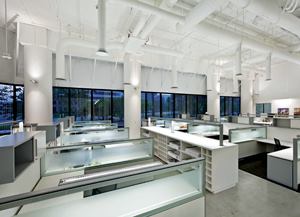Another SCE pilot project involved a redesign of executive office suites in Rosemead, Calif. The offices, which had been rebuilt in 1999, had incandescent lighting highlighting art objects, T8 U-lamps, and east-west facing windows. The beige-colored ceilings had less than 60 percent reflectance and the light levels were on average about 25 footcandles.
The office suites were outfitted with a range of design solutions including a sophisticated control system, pendant lights over desks, dimming ballasts at workstations, and daylighting controls. On-site instrumentation showed that the new designs dropped the watts per square foot from 1.84 to 0.64 while at the same time doubling the number of footcandles where needed. The instrumentation also verified a decrease in killowatt-hours per square foot per year from 8 to 3.
As these performance results demonstrate, careful lighting designs can substantially save energy costs and environmental resources. Similar pilots are planned, over the next year, for other parts of the country through OTF partners to demonstrate technologies and expose stakeholders to these concepts.
Making smart office spaces with superior luminous environments the norm means increasing connectivity at all levels. Building owners and decision-makers who are demanding higher-performance buildings must be provided with thoughtful solutions that include two-way high-fidelity controls and connectivity. The design community must also be prepared to provide such services to building owners, real estate developers, and others who are eager to take advantage of incentives or rates that are currently available or under development. This effort is made easier by the fact that dimmable ballast costs are dropping (in some instances by as much as $40) and new control requirements are being introduced into energy codes
One significant challenge is that designers, contractors, engineers, and others often lack the specific, detailed training needed to install some advanced control systems. Programs have recently been rolled out by the U.S. Department of Labor, however, that will train electricians on how to install sophisticated lighting-control systems (See “How to Light the Office of the Future,” right.) With all of these efforts, high-quality, energy-efficient lighting can become a permanent fixture in every office building.
Gregg D. Ander, FAIA, is the chief architect at Southern California Edison. He serves on the board of directors of the Sustainable Buildings Industry Council, the New Buildings Institute, the Collaborative for Higher Performance Schools, and the California Commissioning Collaborative. He is the author of Daylighting Performance and Design (Wiley, 2003).
How to Light the Office of the FutureAdvanced Lighting Control (ALC) systems are fundamental features of smart buildings. Switching off lights in unoccupied offices, conference rooms, and toilet rooms during normal business hours can yield energy savings of up to 40 percent in commercial buildings. A system of dimming ballasts, occupancy sensor photocells, and communication-based devices will reduce the lighting load and help to develop Smart Grid infrastructure. That kind of innovative design has been stymied by the fact that installers, designers, electricians, and contractors often lack the specialized training necessary to put those systems in place. As a result, architects and engineers often steer clients away from ALC systems that can improve light quality and productivity. A bold California initiative aims to address that challenge from within the industry. The California Advanced Lighting Controls Training Program (CALCTP) was created to promote the design, installation, and commissioning of ALC systems in commercial buildings by advancing the training and certification of contractors. The idea is based on the principle that market transformation is best achieved through industry organizations and shared standards and practices. The CALCTP team includes investor-owned and municipal utilities, the International Brotherhood of Electrical Workers, the National Electrical Contractors Association, the California Lighting Technology Center, the University of California at Davis, community colleges, manufacturers, and ICF International. The technical and sales trainings—to be held at 30 sites in California—will include both classroom and hands-on lab training on everything from dimming ballasts to high performance T8 lighting systems and Web-enabled controls. There are strong incentives for unions and businesses to go through the training. The CALCTP’s partner utilities, equaling more than 90 percent of the California market, encourage contractors and electricians to be certified in ALC installations. A rise in the number of highly skilled ALC installers promises to spur an upsurge in the supply and demand for lighting controls, while also creating new green jobs for the state. A recent summit at the University of California at Berkeley on employment in the green economy promoted such training efforts as a boon to California’s economy and the environment. “Green technologies will not flourish without a well-trained technical and supporting labor force,” according the summit’s website—irle.berkeley.edu/vial. “There is potential for a ‘win-win-win’ strategy in this growing facet of California’s economy, but it will require careful strategies, educational efforts, and coalitions.” The CALCTP’s stakeholders believe their coalition is well positioned to spur that kind of market transformation and become one of the most momentous lighting initiatives in decades. —G.A. |
